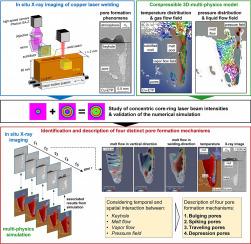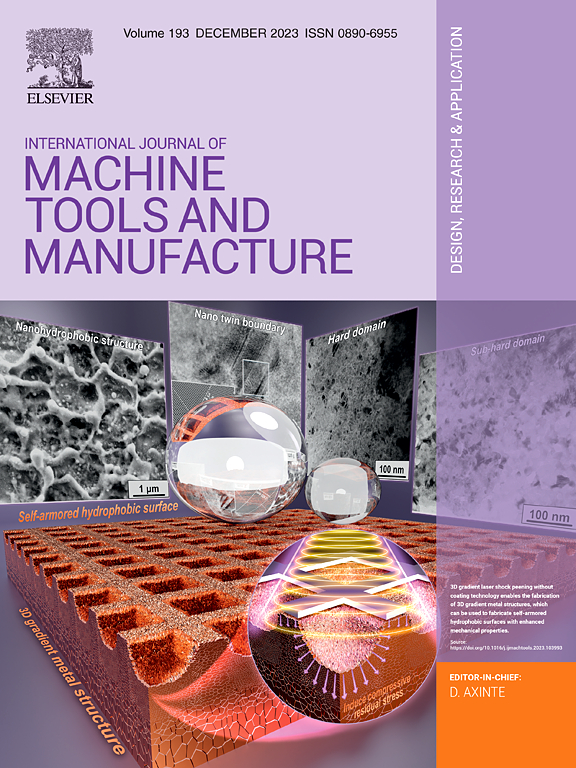Combining in situ synchrotron X-ray imaging and multiphysics simulation to reveal pore formation dynamics in laser welding of copper
IF 18.8
1区 工程技术
Q1 ENGINEERING, MANUFACTURING
International Journal of Machine Tools & Manufacture
Pub Date : 2024-10-28
DOI:10.1016/j.ijmachtools.2024.104224
引用次数: 0
Abstract
Laser beam welding has emerged as a powerful tool for manufacturing copper components in electrical vehicles, electronic devices or energy storage, owing to its rapid processing capabilities. Nonetheless, the material’s high thermal conductivity and low absorption of infrared light can introduce process instabilities, resulting in defects such as pores. This study employs a hybrid approach that combines in situ synchrotron X-ray imaging with compressible multiphysics process simulation to elucidate pore-forming mechanisms during laser beam welding of copper. High-speed synchrotron X-ray imaging with an acquisition rate of 20,000 images/second facilitates the identification of relevant process regimes concerning pore formation during laser beam welding of copper with a wavelength of 1070 nm. Furthermore, in situ observations with high temporal and spatial resolution present a unique database for extensive validation of a multi-physics process simulation based on welding processes using different concentric intensity distributions. These validated simulation results enable thorough comprehension of process-related pore formation based on the interaction between keyhole, melt pool and resulting flow field. The findings show that pore formation is driven by four different mechanisms: bulging, spiking, upwelling waves at the keyhole rear wall and melt pool ejections. The synergy of high-speed synchrotron X-ray imaging and multi-physics modeling provides a fundamental understanding of the chronological sequence of events leading to process-related pore formation during laser beam welding of copper.

结合原位同步辐射 X 射线成像和多物理场模拟揭示铜激光焊接中的孔隙形成动力学
激光束焊接因其快速的加工能力,已成为制造电动汽车、电子设备或能源储存领域铜部件的有力工具。然而,铜材料的高热导率和对红外光的低吸收率会导致加工过程不稳定,从而产生气孔等缺陷。本研究采用了一种混合方法,将原位同步辐射 X 射线成像与可压缩多物理场过程模拟相结合,以阐明铜激光束焊接过程中的孔隙形成机制。以每秒 20,000 张图像的采集速度进行的高速同步辐射 X 射线成像有助于确定波长为 1070 纳米的铜激光焊接过程中孔隙形成的相关过程机制。此外,具有高时间和空间分辨率的现场观测还提供了一个独特的数据库,用于广泛验证基于使用不同同心强度分布的焊接过程的多物理过程模拟。这些经过验证的模拟结果使我们能够根据钥匙孔、熔池和由此产生的流场之间的相互作用,透彻地理解与工艺相关的孔隙形成。研究结果表明,孔隙的形成是由四种不同的机制驱动的:隆起、尖峰、键孔后壁的上涌波和熔池喷射。通过高速同步辐射 X 射线成像和多物理场建模的协同作用,可以从根本上了解铜激光束焊接过程中与工艺相关的孔隙形成事件的时间顺序。
本文章由计算机程序翻译,如有差异,请以英文原文为准。
求助全文
约1分钟内获得全文
求助全文
来源期刊
CiteScore
25.70
自引率
10.00%
发文量
66
审稿时长
18 days
期刊介绍:
The International Journal of Machine Tools and Manufacture is dedicated to advancing scientific comprehension of the fundamental mechanics involved in processes and machines utilized in the manufacturing of engineering components. While the primary focus is on metals, the journal also explores applications in composites, ceramics, and other structural or functional materials. The coverage includes a diverse range of topics:
- Essential mechanics of processes involving material removal, accretion, and deformation, encompassing solid, semi-solid, or particulate forms.
- Significant scientific advancements in existing or new processes and machines.
- In-depth characterization of workpiece materials (structure/surfaces) through advanced techniques (e.g., SEM, EDS, TEM, EBSD, AES, Raman spectroscopy) to unveil new phenomenological aspects governing manufacturing processes.
- Tool design, utilization, and comprehensive studies of failure mechanisms.
- Innovative concepts of machine tools, fixtures, and tool holders supported by modeling and demonstrations relevant to manufacturing processes within the journal's scope.
- Novel scientific contributions exploring interactions between the machine tool, control system, software design, and processes.
- Studies elucidating specific mechanisms governing niche processes (e.g., ultra-high precision, nano/atomic level manufacturing with either mechanical or non-mechanical "tools").
- Innovative approaches, underpinned by thorough scientific analysis, addressing emerging or breakthrough processes (e.g., bio-inspired manufacturing) and/or applications (e.g., ultra-high precision optics).

 求助内容:
求助内容: 应助结果提醒方式:
应助结果提醒方式:


